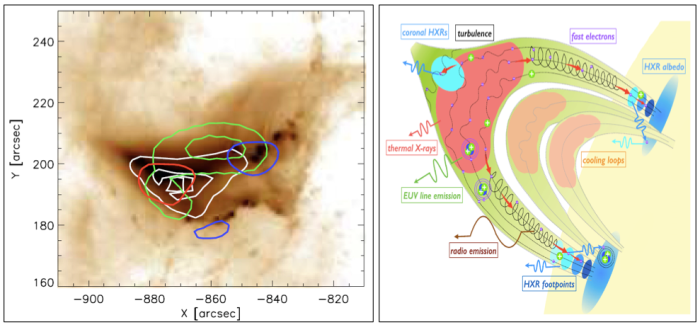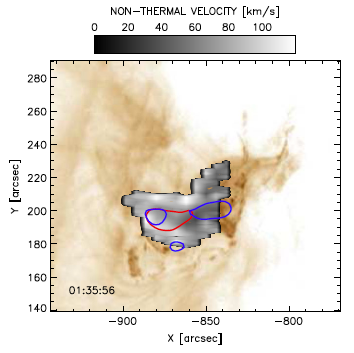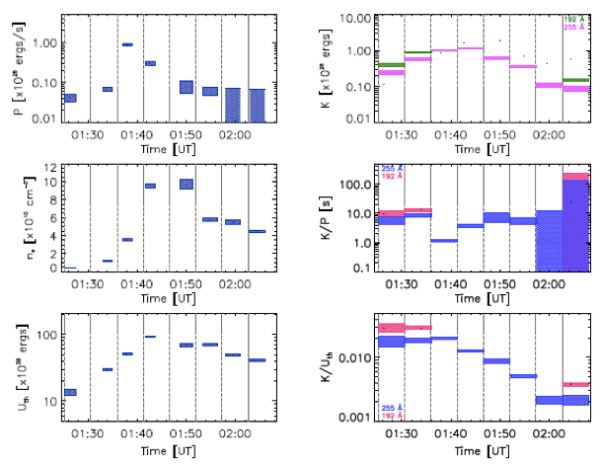The Power of Turbulence
| Nugget | |
|---|---|
| Number: | 308 |
| 1st Author: | Nic Bian |
| 2nd Author: | |
| Published: | 25 September 2017 |
| Next Nugget: | NuSTAR |
| Previous Nugget: | The Kelvin Force |
Introduction
In a solar flare, or any other transient astronomical event, magnetic turbulence may in principle occur at any point in space or time. Its existence has powerful implications for many aspects of the process, and can have strong links to observational properties. In this Nugget we describe the flare SOL2013-05-13 (X1.2), making (via Ref. [1]) full use of turbulence theory.
This well-studied flare was observed, as is typical now, by a whole fleet of wonderful telescopes in space and on the ground. We have used data from RHESSI, as well as from [AIA], [HMI], [Hinode/EIS]. and the [Nobeyama Solar Observatory]. Figure 1 shows the multiwavelength morphology of the flare along with a cartoon summarizing the different flare components. A snapshot of the turbulent component is shown in Figure 2 based on the analysis of the Fe XXIV 255 Å line profile which reveals a plasma at temperature 10-15 MK (million Kelvin). The line shape on each pixel in the grey shade area in the image is close to a [Gaussian] but the width of the Gaussian is larger than expected from the [Doppler] signature of ion thermal motions at the likely temperature. This "non-thermal broadening" of spectral lines could result from the bulk motion of the emitting ions, here of order 100 km/s, in addition to their random thermal motion. Since the measured line of sight PDF of the ion flows is close to a Gaussian we argue that these excess flows result from plasma turbulence. Given that the magnetic field lines are frozen-in the ion flow we conjecture that the grey area in Figure 2 is the location where both turbulence and magnetic reconnection occur. Thus our analysis simply assumes that the observed nonthermal line-width excess results from turbulence.


Energetics and timing
We now focus on the energetics and the timing of the event, using. an energy input rate P defined by the non-thermal bremsstrahlung observed by RHESSI. Figure 3 shows our estimate of the ratio K/P between the turbulent kinetic energy K (from EIS) and the input power P (from RHESSI). This ratio has units of time and Figure 3 shws that it maintains a relatively constant value in the range 1-10 s.
This time scale turns out to be close to the Alfven time which is the time it takes for [Alfven waves] to transit the observed length of the flare loops at the Alfven speed, which we estimate at 1000 km/s from a magnetic field of 300 G, density 1011 cm-3, and scale 10,000 km. Interestingly, the turbulent kinetic energy K always remains quite small compared to the thermal energy and also compared to the estimated magnetic energy. But if the Alfven time is a good estimate of the dissipation time, which would be reasonable, the turbulent power comes up to the level of the power in non-thermal electrons. Thus we infer that the turbulent component of flare energy, seldom previously estimated, may rival the other major components of the released energy in solar flares (see, e.g., Ref. [1]).
Conclusion
In summary, the observations presented here demonstrate the presence of a significant energy reservoir in turbulent motions, which correlates well in space and time with the observed production of non-thermal electrons. This reservoir can also be identified with a possible region of magnetic reconnection, necessary for the magnetic restructuring in the flare. The analysis (Ref. [1]) supports the idea that the turbulence acts as a reservoir, mediating the transfer of energy from reconnecting magnetic fields to accelerated particles in solar flares and presumably in other astrophysical acceleration sites as well.
References
[1] "Turbulent Kinetic Energy in the Energy Balance of a Solar Flare"
[2] "Global Energetics of Thirty-eight Large Solar Eruptive Events"
